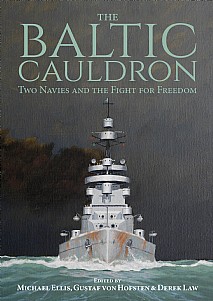
The Baltic Cauldron. Two Navies and the Fight for Freedom. Edited by Michael Ellis, Gustaf von Hofsten and Derek Law. Whittles Publishing, Dunbeath, Scotland, 2023. ISBN 978-184995-549-2
Reviewed by David Hobbs
This book evolved from a work originally published in Swedish in 2022 to mark the 500th anniversary of the Royal Swedish Navy but it contributes more than that to the historiography of naval operations.
It combines the work of fifteen contributors to describe the close relationship that has existed between the Royal Navy and the Royal Swedish Navy from 1522 to the present day. Of these, seven are British, six are Swedish, one an American and the chapters originally written in Swedish were translated into English by Stephanie Sewell from New Zealand.
The book is beautifully illustrated with both colour and black and white maps, paintings and photographs chosen carefully to illustrate the topics being described. When I received my copy I was not quite sure what to expect but was delighted by the wealth of informative material I found woven around the central Baltic theme to illustrate the close relationship between the two navies. There is material that will interest a wide range of readers including the defence of trade and the critical importance to the Royal Navy of masts, timber, tar and other naval stores from the Baltic throughout the sailing era. The Baltic operations of Sir John Norris in the eighteenth century and Vice Admiral Lord Nelson in the nineteenth are described together with the Russo-Swedish war of 1788-1790.
There are chapters that describe the naval operations that took place in the Baltic during what is generally referred to as the Crimean War of 1854-1855 and the Royal Navy’s Baltic operations against the Bolsheviks in defence of Latvian independence between 1918 and 1920; both subjects that are often overlooked in more general histories. The description of how intelligence about the sailing of Bismarck and Prinz Eugen in May 1941 was passed to the Admiralty gave a new dimension to a well-known story but the chapter that many readers will find of particular interest describes Operation Paul, a planned mine-laying operation by British carrier-borne aircraft off the neutral Swedish port of Lulea in May 1940. It was one of several plans driven forward by Winston Churchill with the aim of preventing German ships carrying Swedish iron ore across the Baltic to Germany but there were grave misgivings in the Allied Governments about launching an unprovoked attack on a neutral country. The loss of the carrier Glorious, the Allied evacuation from Narvik and the German offensive against the west which led rapidly to the collapse of Holland, Belgium and France drew Churchill’s attention elsewhere and, while the operation was never specifically cancelled, it was not carried out and the carriers moved on to other tasks. The chapter reveals the depth of planning that went into it, however, and poses several historical ‘what-ifs’.
The last chapters describe events after 1945 with emphases on the transfer of naval technology from the UK to Sweden, the transfer of the midget submarine X-51 and the contemporary defence of shipping in the Strait of Hormuz using the example of a Swedish-owned, British-flagged tanker escorted by the Royal Navy.
The book ends with words of reflection by Admiral Lord West GCB DSC PC, First Sea Lord between 2002 and 2006. He writes that the authors ‘have succeeded in their determination to deepen understanding of the concept of sea power and the inherent abilities and international character of navies’; this sentence sums up the book perfectly. It is a well-presented, thought-provoking book that covers a wider range of material than the title suggests. I thoroughly enjoyed reading it and am delighted to recommend it to ANI members. It has expanded my knowledge of Baltic operations and their wider influence across the centuries and my copy has already taken its place in my library.



